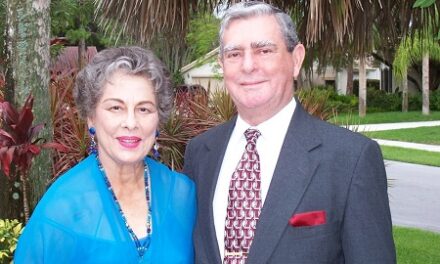.jpg) As the new president and CEO of the North Broward Hospital District, Dr. Nabil El Sanadi will be leading one of the largest public health systems in the United States. And while the job will certainly keep him busy, he is used to working in high-pressure situations as the former chief of emergency medicine for Broward Health, where he was responsible for overseeing four emergency departments and three urgent care centers, including one of the busiest emergency rooms in South Florida.
As the new president and CEO of the North Broward Hospital District, Dr. Nabil El Sanadi will be leading one of the largest public health systems in the United States. And while the job will certainly keep him busy, he is used to working in high-pressure situations as the former chief of emergency medicine for Broward Health, where he was responsible for overseeing four emergency departments and three urgent care centers, including one of the busiest emergency rooms in South Florida.
Since taking the job in December, he has already begun focusing his efforts on creating a more patient-centered health system. “The bottom line is that we need to be more accessible to our patients, who are also our stakeholders,” he explained. “We already provide superb quality care, and we need to maintain that level of care. But we also need to showcase and improve upon what we have to offer. We owe our patients access and excellent quality care, but it must also be cost-effective.”
Dr. El Sanadi says that he is excited about the opportunity to shift roles from being a doctor-manager to becoming a manager-doctor. “For years, I’ve been managing the front end of patient care, but now I’ll also be managing the operations of the health system, including inpatient and satellite facilities,” he said. “While we have a lot of very talented people here, this will also give me the chance to hire thought leaders who are able to move us to an even higher level of clinical, evidence-based medicine.”
Dr. El Sanadi credits Broward’s former CEO, Frank Nask, with leaving the health care system on a very good financial footing, which will enable him to move the hospital forward. “One of my goals is to fill the gaps in accessing clinical care that are not already filled in our community, focusing on what our customers need,” he said. “For example, in the pediatric services arena, we may look at hiring specialists in pediatric nephrology or pediatric rheumatology.”
Patient access at all levels is important, whether through brick-and-mortar facilities or the virtual world, according to Dr. El Sanadi. “We are going to push hard to provide technology that lets patients interface with the health care system in a better way,” he said. “During the holiday season, I shop on the Internet, and I look at things like Consumer Reports that provides information on the safety, longevity, quality and costs of products. Our future patients will use social media and the Internet in the same way to find medical care and to see what services are provided at Broward Health.”
As patients move toward telemedicine and more outpatient options, it will also require health system CEOs to find better uses for their physical facilities. “There is currently too much brick-and-mortar overcapacity as far as hospitals go; the average occupancy rate is 52 percent, which means that we are at 48 percent overcapacity,” said Dr. El Sanadi. “We must find creative ways to use this capacity—maybe not through mergers or consolidation, but by providing private rooms instead of two-bed rooms, or by using this space for long-term care or classroom and educational facilities.
“Health care has been driven into outpatient settings as the result of technology and safety measures, which means that there are a lot more urgent care and surgery centers out there,” he added. “Instead of huge hospitals, I see hospitals shrinking in size through the redeployment of resources, which in turn provides more patient-facing access points.”
A Six Sigma Black Belt who earned his MBA from Case University, Dr. El Sanadi is a firm believer in the value of evidence-based management that uses qualitative analysis to measure the impacts of actions. “If you add three FTEs (full-time equivalents) of nursing to the ER rank and file, for example, you need to measure the costs and determine how it positively or negatively impacts access and quality of care,” he explained.
“My vision is to build Broward Hospital and the health system into a very responsive, efficient health care system that takes advantage of all of the opportunities presented to it, including those that come with the Affordable Care Act,” he added. “While the ACA is a shifting horizon where the landscape is still being developed, if we are efficient, flexible and very good at providing health care, we’ll be able to adapt quickly to whatever opportunities arise.”
Dr. El Sanadi also wants to showcase all of the excellent clinical work already going on at Broward Health System, especially in the area of pediatric care. “We have a pediatric residency here, but very few people actually know about the quality of our medical education,” he said. “As a statutory teaching hospital, we offer nine different teaching programs.”
Education will also play a role in providing patients with wellness and prevention services, which will include addressing initiatives that Dr. El Sanadi helped put in place as the immediate past chairman of the board of medicine for South Florida. “There is a huge issue here as far as patients being overweight or obese, and I’ve worked closely with the state surgeon general on a healthy weight initiative, which we will continue to push on a local level,” said the doctor. Other initiatives that will receive attention include not texting and driving; wearing helmets; using gun locks; stopping recreational drug use and abuse and not smoking.
While his new duties are going to keep him quite busy, Dr. El Sanadi plans to still spend time working with patients, taking one to two shifts per month in the hospital. “I will continue to work as a doctor, though not until after I get my administrative duties underway and get a team in place, which is probably 60 to 90 days out,” he said, adding that within South Florida, there are four or five CEO physicians who continue to do clinical work.
“A study has shown that hospitals run by physician CEOs have better patient stats and outcomes,” he added, referencing a 2011 study in the journal Social Science and Medicine, which ranked 300 top-rated hospitals and found that hospitals with doctors in charge had overall quality scores 25 percent higher than ones led by someone with a nonmedical background. “This could be because that leadership is very in tune with what safety/satisfaction issues are in terms of their hospital populations.”
One thing that working with patients has shown him is that patient-centered care is the right way to go. “You expect doctors to be able and capable, but are they receptive and do they cater to the intellectual, emotional and physical needs of their patients?” he asked. “You have to be able to communicate within the environment of the patient. At Broward, for example, we have a lot of Hispanic or Creole-speaking patients, and we need to continue to retrofit our culture to fit the needs of our community.”


























